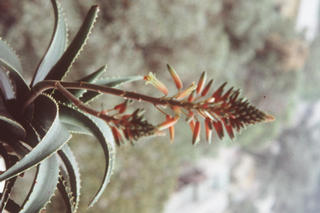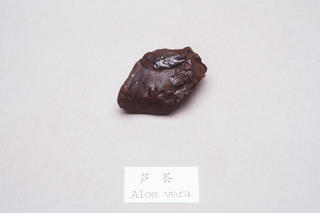Aloe ferox
Contents
Nomenclature
Other Names:
Historical Use of Aloe ferox
Aloe ferox in Traditional Chinese Medicine
Background
Chinese Name (pinyin): Luhui
Chinese Name :
Common Name :Aloe
Specific Name : Aloe
Scientific Name:
Collection :
Description : Old Aloes: Irregular pieces, often broken polygonal, varying in size, externally dark reddish-brown or dark-brown, lusterless. Texture light and hard, uneasily broken, fracture rough or with pockmarked striations, hygroscopic. Odour characteristic, taste: very bitter.New Aloes: Externally dark-brown, slightly green, lustrous. Texture light and lax, easily broken, fracture glassy with striations.
Identification : 1.To 0.5g of the powder, add 50ml of water, shake thoroughly and filter. To 50ml of the filtrate add 0.2g of borax, heat to dissolve. To several drops of the solution add 30ml of water, mix well, a green fluorescence is produced. Examine under ultra-violet light (365nm), a light yellow fluorescence is produced. To 2ml of the filtrate, add 2ml of nitric acid, mix well, a brownish-red color is produced for Aloe barbadensis, and a yellowish-green color for Aloe ferax. To 2ml of the filtrate, add an equal volume of saturated bromine water, a yellow precipitate is produced.2.To 0.1g of the powder, add 5 ml of ferric chloride TS and 5ml of dilute hydrochloric acid, shake thoroughly, heat on a water bath for 5 minutes. Allow to cool add 10ml of carbon tetrachlorideand shake slowly for 1 minute. 6ml of carbon tetrachloride solution add 3ml of ammonia TS and shake, a rose-red to cherry-red color is produced in the ammonia layer.3.0.5g of the powder, add 20ml of methanol, boil on a water bath, shake for several minutes and filter. Use the filtrate as the test solution. Dissolve aloin CRS in mathanol to prepare a solution containing 5mg per ml as the reference solution. Carry out the method for, thin layer chromatography (Appendix Vl B), using silica gel G as the coating substance and ethyl acetate-methanol-water (100:17:13) as the mobile phase. Apply separately to the plate 5µl each of two solutions. After developing and removal of the plate, dry it in the air and spray with 10% solution of potassium hydroxide in methanol. Examine under-ultra violet light (365nm). A fluorescent spot in the chromatogram obtained with the test solution corresponds in position and color to the fluorescent spot in the chromatogram obtained with reference solution.Water: Carry out the determination of water (Appendix lX H, method 1) not more than 12.0%.Total Ash: Not more than 4.0% (Appendix lX K).Assay: Moisten 0.15g of Old Aloes or 0.2g of New Aloes powder (pass through No.5 sieve). Accurately weighed with 1ml of methanol in a 500ml volumetric flask, mix with 5ml of water previously warmed about 60ºC, add further 75ml of water at about 60ºC and shake for 30 minutes, cool, add water to volume, shake and filter. Discard the initial filtrate, transfer accurately 10ml of the successive filtrate to flask containing 1ml of 60% ferric chloride solution and 6ml of hydrochloric acid, heat under reflux on a water bath for 4 hours. Allow to cool, transfer the solution to a separator, wash the flask with 4ml of sodium hydroxide solution (1 mol/L) and 4ml of water in portions, combine the washings in the separator. Extract with 3 quantities each of 20ml of carbon tetrachloride, extract with 2 quantities, each of 10 ml of water, discard the water solution. Transfer the extracts to a 100ml volumetric flask, add carbon tetrachloride to volume and mix well. Evaporate carefully 20ml accurately measured on the water bath, add accurate 10ml of 0.5% solution of magnesium acetate in methanol to dissolve. Measure the absorbance at 512nm (Appendix VB). Calculate the content of C20H20O8, taking the 240 as the value of A (1%, 1cm).Old Aloes contains not less than 28.0% of anhydrous aloin.New Aloes not less than 18.0% calculated on the dried basis.
Processing : Cut into small pieces.
Action :
Indication : constipation; infantile malnutrition due to improper feeding and convulsion
external: eczema, tinea
Precautions :
Dosage :
Storage :
Synonymns for Aloe ferox
Patent Medicines and Medicines with Multiple Ingredients that include Aloe ferox
Pharmaceutical Information
Chemical Constituents
Evidence or the Use of Aloe ferox in the Treatment of Epilepesy
Basic Science
Animal Studies
Cohort, Case-Control and Non-Randomized Trials
Randomized Controlled Trials
Meta-Analysis
1st Five Results: pubmed search
Francesca Comas-Serra, Juan José Martínez-García, Alma Pérez-Alba, María de Los Ángeles Sáenz-Esqueda, María Guadalupe Candelas-Cadillo, Antoni Femenia, Rafael Minjares-Fuentes
##Title##
Foods: 2023, 12(4);
[PubMed:36832926]
[WorldCat.org]
[DOI]
(P e)
Célia Breaud, Laura Lallemand, Gary Mares, Fathi Mabrouki, Myriam Bertolotti, Charlotte Simmler, Stéphane Greff, Morgane Mauduit, Gaëtan Herbette, Eldar Garayev, Christophe Lavergne, Maya Cesari, Sok-Siya Bun-Llopet, Béatrice Baghdikian, Elnur Garayev
##Title##
Antioxidants (Basel): 2022, 12(1);
[PubMed:36670912]
[WorldCat.org]
[DOI]
(P e)
James Lwambi Mwinga, Wilfred Otang-Mbeng, Bongani Petros Kubheka, Adeyemi Oladapo Aremu
Ethnobotanical Survey of Plants Used by Subsistence Farmers in Mitigating Cabbage and Spinach Diseases in OR Tambo Municipality, South Africa.
Plants (Basel): 2022, 11(23);
[PubMed:36501255]
[WorldCat.org]
[DOI]
(P e)
Tsolanku Sidney Maliehe, Melusi Mbambo, Londeka Sibusisiwe Ngidi, Jabulani Siyabonga Emmanuel Shandu, Ofentse Jacob Pooe, Peter Masoko, Tlou Nelson Selepe
Bioprospecting of endophytic actinobacterium associated with Aloe ferox mill for antibacterial activity.
BMC Complement Med Ther: 2022, 22(1);258
[PubMed:36192707]
[WorldCat.org]
[DOI]
(I e)
Carolina Diller, Miguel Castañeda-Zárate, Steven D Johnson
Why honeybees are poor pollinators of a mass-flowering plant: Experimental support for the low pollen quality hypothesis.
Am J Bot: 2022, 109(8);1305-1312
[PubMed:35844034]
[WorldCat.org]
[DOI]
(I p)

